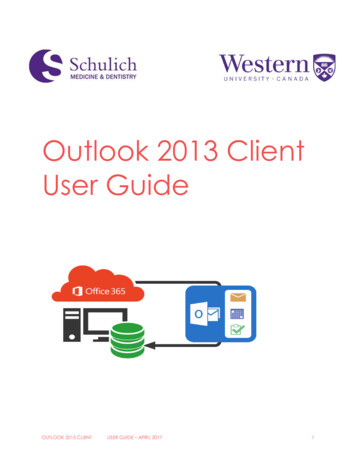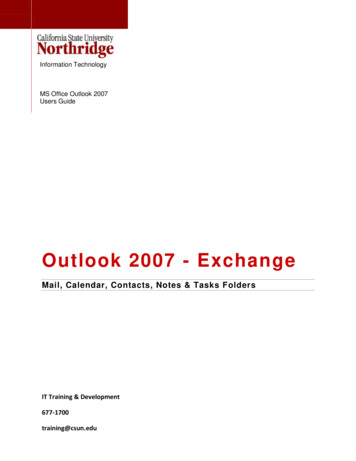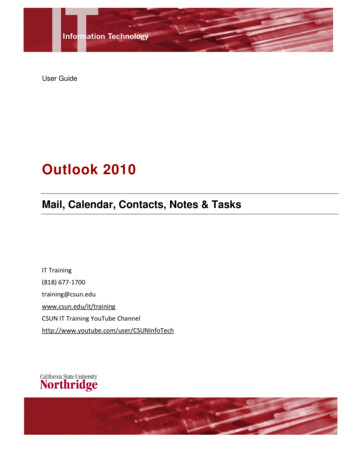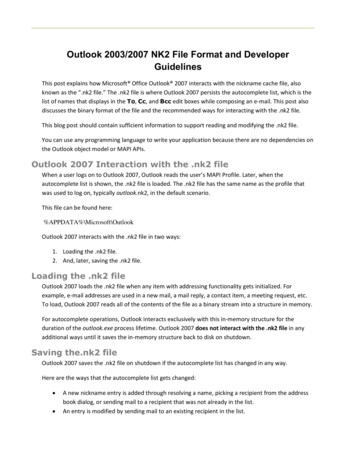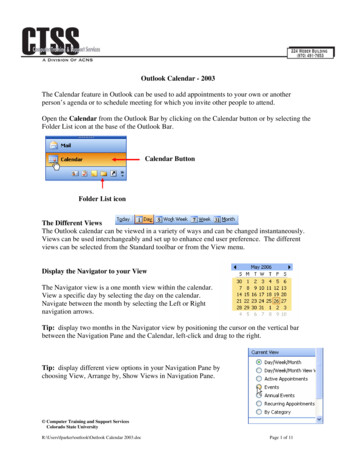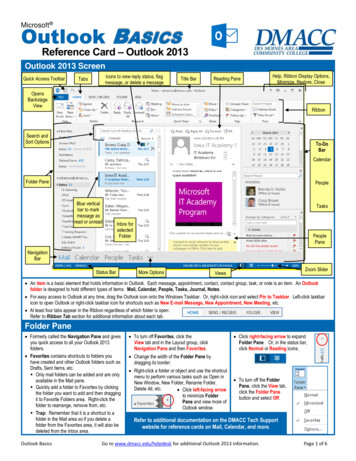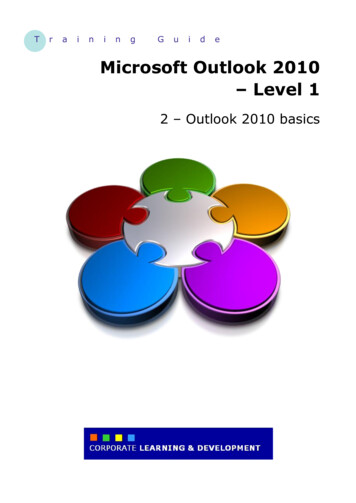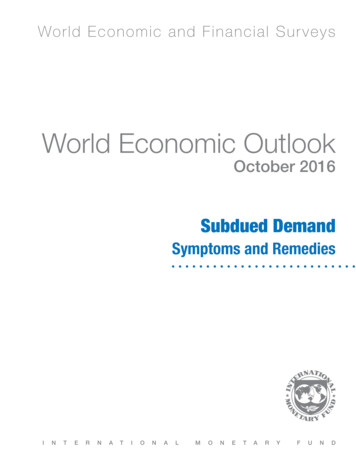
Transcription
Wor l d Eco no m i c a nd F i na nci a l S ur v e y sWorld Economic OutlookOctober 2016Subdued DemandSymptoms and RemediesINTERNATIONALMONETARYFUND
2016 International Monetary FundCover and Design: Luisa Menjivar and Jorge SalazarComposition: AGS, An RR Donnelley CompanyCataloging-in-Publication DataJoint Bank-Fund LibraryNames: International Monetary Fund.Title: World economic outlook (International Monetary Fund)Other titles: WEO Occasional paper (International Monetary Fund) World economic andfinancial surveys.Description: Washington, DC : International Monetary Fund, 1980- Semiannual Someissues also have thematic titles. Began with issue for May 1980. 1981-1984: Occasionalpaper / International Monetary Fund, 0251-6365 1986-: World economic and financialsurveys, 0256-6877.Identifiers: ISSN 0256-6877 (print) ISSN 1564-5215 (online)Subjects: LCSH: Economic development—Periodicals. International economic relations—Periodicals. Debts, External—Periodicals. Balance of payments—Periodicals. International finance—Periodicals. Economic forecasting—Periodicals.Classification: LCC HC10.W79HC10.80ISBN 978-1-51359-954-0 (paper)978-1-47553-996-7 (PDF)978-1-47553-981-3 (ePub)978-1-47553-998-1 (Mobi)The World Economic Outlook (WEO) is a survey by the IMF staff published twice ayear, in the spring and fall. The WEO is prepared by the IMF staff and has benefitedfrom comments and suggestions by Executive Directors following their discussion of thereport on September 23, 2016. The views expressed in this publication are those of theIMF staff and do not necessarily represent the views of the IMF’s Executive Directorsor their national authorities.Recommended citation: International Monetary Fund. 2016. World Economic Outlook:Subdued Demand: Symptoms and Remedies. Washington, October.Publication orders may be placed online, by fax, or through the mail:International Monetary Fund, Publication ServicesP.O. Box 92780, Washington, DC 20090, U.S.A.Tel.: (202) 623-7430 Fax: (202) 623-7201E-mail: ry.imf.org
CONTENTSAssumptions and ConventionsxFurther Information and DataxiPrefacexiiForewordxiiiExecutive SummaryxvChapter 1. Global Prospects and Policies1Recent Developments and ProspectsThe ForecastRisksPolicy PrioritiesScenario Box 1. Tariff ScenariosBox 1.1. World Growth Projections over the Medium TermSpecial Feature: Commodity Market Developments and Forecasts, with a Focus onFood Security and Markets in the World EconomyReferencesChapter 2. Global Trade: What’s behind the Slowdown?11826293740486063The Implications of Trade for Productivity and Welfare: A PrimerThe Slowdown in Trade Growth: Key PatternsUnderstanding the Slowdown in Trade GrowthSummary and Policy ImplicationsBox 2.1. Is the Trade Slowdown Contributing to the Global Productivity Slowdown? New EvidenceBox 2.2. The Role of Trade Policies in Reinvigorating TradeBox 2.3. Potential Gains from Jump-Starting Trade LiberalizationAnnex 2.1. DataAnnex 2.2. Constructing Disaggregated Import Volume and Price IndicesAnnex 2.3. Analysis Using an Empirical Model of Import DemandAnnex 2.4. Analysis Using a General Equilibrium ModelAnnex 2.5. Analysis at the Product LevelAnnex 2.6. Analysis Using Gravity Model of TradeReferencesChapter 3. Global Disinflation in an Era of Constrained Monetary Policy66676985889194959598106107110115121A Primer on the Costs of Disinflation, Persistently Low Inflation, and DeflationInflation Dynamics: Patterns and Recent DriversHow Well Anchored Are Inflation Expectations?Summary and Policy ImplicationsBox 3.1. Industrial Slack and Producer Price InflationBox 3.2. The Japanese Experience with DeflationBox 3.3. How Much Do Global Prices Matter for Food Inflation?International Monetary Fund October 2016124126134142145147150iii
WORLD ECONOMIC OUTLOOK: SUBDUED DEMAND—SYMPTOMS AND REMEDIESBox 3.4. The Impact of Commodity Prices on Producer Price InflationBox 3.5. A Transparent Risk-Management Approach to Monetary PolicyAnnex 3.1. Sample and DataAnnex 3.2. Model SimulationsAnnex 3.3. Principal Component AnalysisAnnex 3.4. Drivers of the Recent Decline in InflationAnnex 3.5. The Effect of Inflation Shocks on Inflation ExpectationsReferencesChapter 4. Spillovers from China’s Transition and from MigrationIntroductionThe Challenges and Opportunities of MigrationBox 4.1. China’s Ties with Low-Income and Developing CountriesBox 4.2. Conflicts Driving Migration: Middle East and North AfricaBox 4.3. Migration in Sub-Saharan AfricaReferencesStatistical AppendixAssumptionsWhat’s NewData and ConventionsCountry NotesClassification of CountriesGeneral Features and Composition of Groups in the World Economic Outlook ClassificationTable A. Classification by World Economic Outlook Groups and Their Shares in Aggregate GDP,Exports of Goods and Services, and Population, 2015Table B. Advanced Economies by SubgroupTable C. European UnionTable D. Emerging Market and Developing Economies by Region and Main Source ofExport EarningsTable E. Emerging Market and Developing Economies by Region, Net External Position, andStatus as Heavily Indebted Poor Countries and Low-Income Developing CountriesTable F. Economies with Exceptional Reporting PeriodsTable G. Key Data DocumentationBox A1. Economic Policy Assumptions Underlying the Projections for Selected EconomiesList of TablesOutput (Tables A1–A4)Inflation (Tables A5–A7)Financial Policies (Table A8)Foreign Trade (Table A9)Current Account Transactions (Tables A10–A12)Balance of Payments and External Financing (Table A13)Flow of Funds (Table A14)Medium-Term Baseline Scenario (Table 240241243250254257World Economic Outlook, Selected Topics259IMF Executive Board Discussion of the Outlook, September 2016267ivInternational Monetary Fund October 2016
CONTENTS TablesTable 1.1. Overview of the World Economic Outlook ProjectionsAnnex Table 1.1.1. Europe: Real GDP, Consumer Prices, Current Account Balance,and UnemploymentAnnex Table 1.1.2. Asia and Pacific: Real GDP, Consumer Prices, Current Account Balance, andUnemploymentAnnex Table 1.1.3. Western Hemisphere: Real GDP, Consumer Prices, Current Account Balance, andUnemploymentAnnex Table 1.1.4. Commonwealth of Independent States: Real GDP, Consumer Prices,Current Account Balance, and UnemploymentAnnex Table 1.1.5. Middle East, North Africa, Afghanistan, and Pakistan: Real GDP, Consumer Prices,Current Account Balance, and UnemploymentAnnex Table 1.1.6. Sub-Saharan Africa: Real GDP, Consumer Prices, Current Account Balance, andUnemploymentTable 1.SF.1. Used-to-Available Land Suitable for Agriculture by Region, 2013Table 1.SF.2. Food ExportsTable 1.SF.3. Agricultural YieldTable 1.SF.4. Urban Population by RegionTable 1.SF.5. Net Export of FoodTable 1.SF.6. Share of Food and Beverages in Total Consumption, 2010Table 1.SF.1.1. Impact of Land Governance and Food Security on Land DealsTable 2.1. Historical Association among Real Import Growth at the Product Level, Trade Policies, andParticipation in Global Value ChainsTable 2.1.1. Baseline Estimation ResultsTable 2.2.1. Trade Policy Challenges Vary across CountriesAnnex Table 2.1.1. Data SourcesAnnex Table 2.1.2. Sample of Economies Included in the Analytical ExercisesAnnex Table 2.3.1. Import Content of Aggregate Demand ComponentsAnnex Table 2.3.2. Empirical Model of Real Imports of Goods and ServicesAnnex Table 2.3.3. Empirical Model of Real Imports of GoodsAnnex Table 2.3.4. Empirical Model of Real Imports of ServicesAnnex Table 2.3.5. Residuals: Real Goods Import GrowthAnnex Table 2.3.6. Residuals: Real Services Import GrowthAnnex Table 2.3.7. Residuals: Real Goods Import Growth Controlling for Global Uncertainty, GlobalFinancial Conditions, and Financial StressAnnex Table 2.3.8. Decomposing the Decline in Real Goods Import Growth: Full SampleAnnex Table 2.3.9. Residuals: Real Goods Import Growth, Corrected for Potential Effect ofTrade Policies on Aggregate DemandAnnex Table 2.3.10. Decomposing the Decline in Real Goods Import GrowthControlling for Trade PoliciesAnnex Table 2.5.1. Alternative Specifications for Real Imports in Product-Level RegressionsAnnex Table 2.5.2. Alternative Specifications for Nominal Imports in Product-Level RegressionsAnnex Table 2.6.1. Link between Global Value Chain Integration and Yearly Nominal ImportGrowth Using Gravity Model Estimated in LevelsAnnex Table 2.6.2. Link between Global Value Chain Integration and Yearly Nominal ImportGrowth Using Gravity Model Estimated in Growth RatesTable 3.3.1. Cross-Country Determinants of Pass-Through of Free-on-Board Food Prices toFood Consumer Price InflationAnnex Table 3.1.1. Sample of Advanced and Emerging Market EconomiesAnnex Table 3.1.2. Data SourcesInternational Monetary Fund October 02103103104104105105109111113114153158158v
WORLD ECONOMIC OUTLOOK: SUBDUED DEMAND—SYMPTOMS AND REMEDIESTable A1. Summary of World OutputTable A2. Advanced Economies: Real GDP and Total Domestic DemandTable A3. Advanced Economies: Components of Real GDPTable A4. Emerging Market and Developing Economies: Real GDPTable A5. Summary of InflationTable A6. Advanced Economies: Consumer PricesTable A7. Emerging Market and Developing Economies: Consumer PricesTable A8. Major Advanced Economies: General Government Fiscal Balances and DebtTable A9. Summary of World Trade Volumes and PricesTable A10. Summary of Current Account BalancesTable A11. Advanced Economies: Balance on Current AccountTable A12. Emerging Market and Developing Economies: Balance on Current AccountTable A13. Summary of Financial Account BalancesTable A14. Summary of Net Lending and BorrowingTable A15. Summary of World Medium-Term Baseline 257Online TablesTable B1. Advanced Economies: Unemployment, Employment, and Real GDP per CapitaTable B2. Emerging Market and Developing Economies: Real GDPTable B3. Advanced Economies: Hourly Earnings, Productivity, and Unit Labor Costs in ManufacturingTable B4. Emerging Market and Developing Economies: Consumer PricesTable B5. Summary of Fiscal and Financial IndicatorsTable B6. Advanced Economies: General and Central Government Net Lending/Borrowing and GeneralGovernment Net Lending/Borrowing Excluding Social Security SchemesTable B7. Advanced Economies: General Government Structural BalancesTable B8. Emerging Market and Developing Economies: General Government Net Lending/Borrowingand Overall Fiscal BalanceTable B9. Emerging Market and Developing Economies: General Government Net Lending/BorrowingTable B10. Selected Advanced Economies: Exchange RatesTable B11. Emerging Market and Developing Economies: Broad Money AggregatesTable B12. Advanced Economies: Export Volumes, Import Volumes, and Terms of Trade in Goods andServicesTable B13. Emerging Market and Developing Economies by Region: Total Trade in GoodsTable B14. Emerging Market and Developing Economies by Source of Export Earnings: TotalTrade in GoodsTable B15. Summary of Current Account TransactionsTable B16. Emerging Market and Developing Economies: Summary of External Debt and Debt ServiceTable B17. Emerging Market and Developing Economies by Region: External Debt by MaturityTable B18. Emerging Market and Developing Economies by Analytical Criteria: ExternalDebt by MaturityTable B19. Emerging Market and Developing Economies: Ratio of External Debt to GDPTable B20. Emerging Market and Developing Economies: Debt-Service RatiosTable B21. Emerging Market and Developing Economies, Medium-Term Baseline Scenario: SelectedEconomic IndicatorsFiguresFigure 1.1. Global Activity IndicatorsFigure 1.2. Global InflationFigure 1.3. Commodity and Oil MarketsFigure 1.4. Real Effective Exchange Rate Changes, March 2016–September 2016viInternational Monetary Fund October 20164667
CONTENTS Figure 1.5. Emerging Market Economies: Capital FlowsFigure 1.6. Advanced Economies: Monetary and Financial Market ConditionsFigure 1.7. Advanced Economies: Credit, House Prices, and Balance SheetsFigure 1.8. Emerging Market Economies: Interest RatesFigure 1.9. Emerging Market Economies: Equity Markets and CreditFigure 1.10. Domestic Demand, Output Gap, Unemployment, and Labor Force Participationin Advanced EconomiesFigure 1.11. DemographicsFigure 1.12. Advanced Economies: Growth, Investment, and Employment in RecentWEO VintagesFigure 1.13. Emerging Markets: Terms-of-Trade Windfall Gains and Losses and RealExchange RatesFigure 1.14. Real per Capita Growth Rates and Convergence (1995–2020)Figure 1.15. Fiscal IndicatorsFigure 1.16. External SectorFigure 1.17. Creditors versus DebtorsFigure 1.18. Current Account Gaps and Real Exchange RatesFigure 1.19. Risks to the Global OutlookFigure 1.20. Recession and Deflation RisksScenario Figure 1. Unilateral and Bilateral Imposition of Tariffs on Imported GoodsScenario Figure 2. A Worldwide Increase in ProtectionismFigure 1.1.1 World Growth Projections over the Medium TermFigure 1.SF.1. Commodity Market DevelopmentsFigure 1.SF.2. Producer Support EstimateFigure 1.SF.3. World Food Production and Consumption by Country, 2015Figure 1.SF.4. Population and World Food ConsumptionFigure 1.SF.5. Maize YieldFigure 1.SF.6. Food Prices and Violent EventsFigure 1.SF.7. Global Food Security Index, 2016Figure 1.SF.1.1. Evolution of Deals over Time by Target RegionFigure 2.1. World Real Trade and GDP Growth in Historical PerspectiveFigure 2.2. World Trade in Volumes, Values, and across CountriesFigure 2.3. Trade Dynamics across Broad Country GroupsFigure 2.4. Trade Dynamics across Types of Trade and ProductsFigure 2.5. Empirical Model: Actual and Predicted Evolution of Real Import GrowthFigure 2.6. Empirical Model: Difference between Actual and Predicted Growth of RealGoods ImportsFigure 2.7. Empirical Model: Decomposing the Slowdown in Real Goods Import GrowthFigure 2.8. Structural Model: Actual and Model-Implied Evolution of NominalImport-to-GDP RatioFigure 2.9. Trade Costs in Historical Perspective: A Top-Down ApproachFigure 2.10. Trade Policies in Historical PerspectiveFigure 2.11. Logistics and Transportation Costs of Trade in Historical PerspectiveFigure 2.12. Global Value Chains in Historical PerspectiveFigure 2.13. Contribution of Trade Policies and Global Value Chains to the Slowdown in RealGoods Import GrowthFigure 2.14. Gravity Model: Global Value Chain Participation and Bilateral Sectoral Trade GrowthFigure 2.1.1. The Evolution of Trade across Industries in Major EconomiesFigure 2.2.1. Potential Gains from Tackling Traditional Trade BarriersFigure 2.2.2. Trade Policy Frontier AreasInternational Monetary Fund October 657586468707072737377798082828586899393vii
WORLD ECONOMIC OUTLOOK: SUBDUED DEMAND—SYMPTOMS AND REMEDIESFigure 2.3.1. Gains from Eliminating Tariffs and Implementing the World Trade OrganizationTrade Facilitation AgreementAnnex Figure 2.1.1. Nominal Import Growth across Categories of ServicesAnnex Figure 2.2.1. Real Import GrowthAnnex Figure 2.5.1. Trade Finance AvailabilityAnnex Figure 2.5.2. Contribution of Trade Policies and Global Value Chains to the Slowdown inReal and Nominal Goods Import GrowthFigure 3.1. Oil Prices and Consumer Price InflationFigure 3.2. Share of Countries with Low InflationFigure 3.3. Medium-Term Inflation Expectations and Oil PricesFigure 3.4. Effect of Disinflationary Shocks in Advanced Economies under Constrained MonetaryPolicy and Unanchored Inflation ExpectationsFigure 3.5. Consumer Price InflationFigure 3.6. Share of Consumer Price Inflation Variation Explained by First Common FactorFigure 3.7. Core Consumer Price InflationFigure 3.8. Wage Inflation in Advanced EconomiesFigure 3.9. Sectoral Producer Prices in Advanced EconomiesFigure 3.10. Sectoral Consumer Prices in Advanced EconomiesFigure 3.11. Estimated Phillips Curve ParametersFigure 3.12. Contribution to Inflation Deviations from Targets: Advanced EconomiesFigure 3.13. Contribution to Inflation Deviations from Targets: Emerging Market EconomiesFigure 3.14. Correlation of Manufacturing Slack in China, Japan, and the United States withImport Price Contribution to Inflation in Other EconomiesFigure 3.15. Survey- and Market-Based Inflation ExpectationsFigure 3.16. Sensitivity of Inflation Expectations to Inflation SurprisesFigure 3.17. Sensitivity of Inflation Expectations to Inflation Surprises and MonetaryPolicy FrameworksFigure 3.18. Sensitivity of Inflation Expectations to Inflation Surprises before and after Adoptionof Inflation TargetingFigure 3.19. Sensitivity of Inflation Expectations to Inflation Surprises over TimeFigure 3.20. Change in Sensitivity of Inflation Expectations to Inflation SurprisesFigure 3.21. Average Sensitivity of Inflation Expectations to Inflation Surprises in Countries at theEffective Lower BoundFigure 3.22. Sensitivity of Longer-Term Inflation Expectations to Changes in Oil PricesFigure 3.1.1. Producer Price and Consumer Price Inflation in China, Japan, and the United StatesFigure 3.1.2. Industrial Slack in China, Japan, and the United StatesFigure 3.1.3. Decomposition for Total Producer Price Inflation for China, Japan, and theUnited StatesFigure 3.2.1. Inflation DynamicsFigure 3.2.2. Cyclical and Structural Indicators in JapanFigure 3.2.3. Policy Indicators in JapanFigure 3.3.1. Food Weights in Consumption and per Capita GDPFigure 3.3.2. World Food Prices and Consumer Food PricesFigure 3.3.3. Food Prices Relative to Nonfood PricesFigure 3.3.4. Food Pass-Through Coefficients for Various Country GroupsFigure 3.3.5. Distribution of Food Pass-Through CoefficientsFigure 3.4.1. Commodity Prices and Producer PricesFigure 3.4.2. Contribution to Cumulative Producer Price InflationFigure 3.5.1. Forecast as Envisaged at 2009:Q2: Loss-Minimization versus Linear Reaction FunctionviiiInternational Monetary Fund October 150151151152152154155156
CONTENTS Annex Figure 3.2.1. Effect of Disinflationary Shocks on Core Inflation in Advanced Economies underConstrained Monetary PolicyAnnex Figure 3.2.2. Effect of Disinflationary Shocks on Core Inflation in Advanced Economies underConstrained Monetary Policy and Unanchored Inflation ExpectationsAnnex Figure 3.3.1. Share of Consumer Price Inflation Variation Explained by Different FactorsAnnex Figure 3.3.2. First Common Factor and Commodity PricesAnnex Figure 3.4.1. Contribution to Inflation Deviations from Targets Using Various Measuresof Inflation ExpectationsAnnex Figure 3.4.2. Contribution to Inflation Deviations from Targets Using Various Measures ofCyclical UnemploymentAnnex Figure 3.4.3. Correlation of Manufacturing Slack in China, Japan, and the United Stateswith Import Price Contribution to Inflation in Other EconomiesAnnex Figure 3.4.4. Correlation of China Manufacturing Slack with Import Price Contribution toInflation in Other Economies: Results from Panel RegressionsAnnex Figure 3.5.1. Change in Inflation Expectations and Inflation ShocksAnnex Figure 3.5.2. Sensitivity of Inflation Expectations when Controlling for Slack:Advanced EconomiesFigure 4.1. China: GDP and Trade GrowthFigure 4.2. Number of International Migrants and RefugeesFigure 4.3. China: Global Clout and RebalancingFigure 4.4. Spillovers from China over TimeFigure 4.5. Impact on Exports of a 1 Percent Shock to China’s Demand after One YearFigure 4.6. Decline in Average Export Growth Rate Attributed to China Demand,2014:Q1–2015:Q3Figure 4.7. China: Processing TradeFigure 4.8. A Large Footprint in Commodity MarketsFigure 4.9. Cumulative One-Year Price Impact from a 1 Percent Shock to China’sIndustrial ProductionFigure 4.10. China: Slowdown ScenarioFigure 4.11. Spillovers from ChinaFigure 4.12. Transmission of Spillovers through Financial ChannelsFigure 4.13. China: Cyclical Slowdown ScenarioFigure 4.14. International Migrants and RefugeesFigure 4.15. Migration by Age and SkillFigure 4.16. Determinants of MigrationFigure 4.17. Females: Low Education versus High Skilled, 2000Figure 4.18. Labor Market PerformanceFigure 4.19. Germany: Present Value of Expected Future Net Fiscal Contribution by Age GroupFigure 4.20. Estimated Impact of Migration in More Developed Economies, 2100Figure 4.21. Migration: Positive Longer-Term Growth EffectsFigure 4.22. Contributions of Outward Migration to Population GrowthFigure 4.23. Migration of Population with Tertiary EducationFigure 4.24. Remittances and DiasporasFigure 4.1.1. China’s Ties with Low-Income and Developing CountriesFigure 4.3.1. Migration in Sub-Saharan AfricaFigure 4.3.2. Age and Education of Migrants and Origin Country PopulationFigure 4.3.3. Top Receivers of Remittances in Sub-Saharan Africa, 2013–15International Monetary Fund October 192193195197198198ix
Editor’s noteOctober 4, 2016Statistical Tables A2 and A6 have been replaced to correct incorrect values for Macao SAR, Iceland, and SanMarino in the first column of each table.
WORLD ECONOMIC OUTLOOK: TENSIONS FROM THE TWO-SPEED RECOVERYASSUMPTIONS AND CONVENTIONSA number of assumptions have been adopted for the projections presented in the World Economic Outlook(WEO). It has been assumed that real effective exchange rates remained constant at their average levels during July22 to August 19, 2016, except for those for the currencies participating in the European exchange rate mechanismII (ERM II), which are assumed to have remained constant in nominal terms relative to the euro; that establishedpolicies of national authorities will be maintained (for specific assumptions about fiscal and monetary policies forselected economies, see Box A1 in the Statistical Appendix); that the average price of oil will be 42.96 a barrelin 2016 and 50.64 a barrel in 2017 and will remain unchanged in real terms over the medium term; that thesix-month London interbank offered rate (LIBOR) on U.S. dollar deposits will average 1.0 percent in 2016 and1.3 percent in 2017; that the three-month euro deposit rate will average –0.3 percent in 2016 and –0.4 percent in2017; and that the six-month Japanese yen deposit rate will yield on average 0.0 percent in 2016 and –0.1 percentin 2017. These are, of course, working hypotheses rather than forecasts, and the uncertainties surrounding themadd to the margin of error that would in any event be involved in the projections. The estimates and projectionsare based on statistical information available through September 16, 2016.The following conventions are used throughout the WEO:. . . to indicate that data are not available or not applicable;– between years or months (for example, 2015–16 or January–June) to indicate the years or months covered, including the beginning and ending years or months; and/between years or months (for example, 2015/16) to indicate a fiscal or financial year.“Billion” means a thousand million; “trillion” means a thousand billion.“Basis points” refers to hundredths of 1 percentage point (for example, 25 basis points are equivalent to ¼ of 1percentage point).Data refer to calendar years, except in the case of a few countries that use fiscal years. Please refer to Table F inthe Statistical Appendix, which lists the economies with exceptional reporting periods for national accounts andgovernment finance data for each country.For some countries, the figures for 2015 and earlier are based on estimates rather than actual outturns. Pleaserefer to Table G in the Statistical Appendix, which lists the latest actual outturns for the indicators in the nationalaccounts, prices, government finance, and balance of payments indicators for each country.In the tables and figures, the following conventions apply: If no source is listed on tables and figures, data are drawn from the WEO database. When countries are not listed alphabetically, they are ordered on the basis of economic size. Minor discrepancies between sums of constituent figures and totals shown reflect rounding.As used in this report, the terms “country” and “economy” do not in all cases refer to a territorial entity that isa state as understood by international law and practice. As used here, the term also covers some territorial entitiesthat are not states but for which statistical data are maintained on a separate and independent basis.Composite data are provided for various groups of countries organized according to economic characteristics orregion. Unless noted otherwise, country group composites represent calculations based on 90 percent or more ofthe weighted group data.The boundaries, colors, denominations, and any other information shown on the maps do not imply, on thepart of the International Monetary Fund, any judgment on the legal status of any territory or any endorsement oracceptance of such boundaries.xInternational Monetary Fund October 2016International Monetary Fund October 2016x
WORLD ECONOMIC OUTLOOK: TENSIONS FROM THE TWO-SPEED RECOVERYFURTHER INFORMATION AND DATAThis version of the World Economic Outlook (WEO) is available in full through the IMF eLibrary (www.elibrary.imf.org) and the IMF website (www.imf.org). Accompanying the publication on the IMF website is a larger compilation of data from the WEO database than is included in the report itself, including files containing the seriesmost frequently requested by readers. These files may be downloaded for use in a variety of software packages.The data appearing in the World Economic Outlook are compiled by the IMF staff at the time of the WEO exercises. The historical data and projections are based on the information gathered by the IMF country desk officersin the context of their missions to IMF member countries and through their ongoing analysis of the evolving situation in each country. Historical data are updated on a continual basis as more information becomes available, andstructural breaks in data are often adjusted to produce smooth series with the use of splicing and other techniques.IMF staff estimates continue to serve as proxies for historical series when complete information is unavailable.As a result, WEO data can differ from those in other sources with official data, including the IMF’s InternationalFinancial Statistics.The WEO data and metadata provided are “as is” and “as available,” and every effort is made to ensure theirtimeliness, accuracy, and completeness, but it cannot be guaranteed. When errors are discovered, there is a concerted effort to correct them as appropriate and feasible. Corrections and revisions made after publication areincorporated into the electronic editions available from the IMF eLibrary (www.elibrary.imf.org) and on the IMFwebsite (www.imf.org). All substantive changes are listed in detail in the online tables of contents.For details on the terms and conditions for usage of the WEO database, please refer to the IMF Copyright andUsage website (www.imf.org/external/terms.htm).Inquiries about the content of the World Economic Outlook and the WEO database should be sent by mail, fax,or online forum (telephone inquiries cannot be accepted):World Economic Studies DivisionResearch DepartmentInternational Monetary Fund700 19th Street, N.W.Washington, D.C. 20431, U.S.A.Fax: (202) 623-6343Online Forum: www.imf.org/weoforumInternational Monetary Fund October 2016xi
PREFACEThe analysis and projections contained in the World Economic Outlook are integral elements of the IMF’s surveillance of economic developments and policies in its member countries, of developments in international financialmarkets, and of the global economic system. The survey of prospects and policies is the product of a comprehensive interdepartmental review of world economic developments, which draws primarily on information the IMFstaff gathers through its consultations with member countries. These consultations are carried out in particular bythe IMF’s area departments—namely, the African Department, Asia and Pacific Department, European Department, Middle East and Central Asia Department, and Western Hemisphere Department—together with theStrategy, Policy, and Review Department, the Monetary and Capital Markets Department, and the Fiscal AffairsDepartment.The analysis in this report was coordinated in the Research Department under the general direction of MauriceObstfeld, Economic Counsellor and Director of Research. The project was directed by Gian Maria Milesi-Ferretti,Deputy Director, Research Department; Oya Celasun, Division Chief, Research Department; and Helge Berger,Division Chief, Research Department and Head of the IMF’s Spillover Task Force.The primary contributors to this report were Rabah Arezki, Aqib Aslam, Claudia Berg, Samya Beidas-Strom,Patrick Blagrave, Christian Bogmans, Emine Boz, Luis Catão, Eugenio Cerutti, Sangyup Choi, Davide Furceri,Bertrand Gruss, Zsóka Kóczán, Ksenia Koloskova, Toh Kuan, Weicheng Lian, Akito Matsumoto, Malhar Nabar,Marcos Poplawski-Ribeiro, Sweta Saxena, Petia Topalova, and Esteban Vesperoni.Other contributors include Jaebin Ahn, Emre Alper, Michal Andrle, Elif Arbatli, Gavin Asdorian, Felicia Belostecinic, Diego Cerdeiro, Kevin Clinton, Vanessa Diaz Montelongo, Romain Duval, Rupa Duttagupta, AngelaEspiritu, Rachel Yuting Fan, Emily Forrest, Mitko Grigorov, Refet Gürkaynak, Mahnaz Hemmati, Christian Henn,Benjamin Hilgenstock, Niko Hobdari, Ava Yeabin Hong, Keiko Honjo, Benjamin Hunt, Gabi Ionescu, ZoltanMatyas Jakab, Hao Jiang, Alimata Kini-Kaboré, Sinem Kılıç Çelik, Douglas Laxton, Andrei Levchenko, Olivia Ma,Trevor Charles Meadows, Juan Angel Garcia Morales, Brent Neiman, Emory Oakes, Evgenia Pugacheva, RachelSzymanski, Daniel Te Kaat, Sheng Tibung, Nicholas Tong, Ali Uppal, Hou Wang, Niklas Westelius, Jilun Xing,Yuan Zeng,
978-1-47553-996-7 (PDF) 978-1-47553-981-3 (ePub) 978-1-47553-998-1 (Mobi) The World Economic Outlook (WEO) is a survey by the IMF staff published twice a year, in the spring and fall. The WEO is prepared by the IMF staff and has benefited from comments and suggestions by Executive Directors following their discussion of the report on September .

